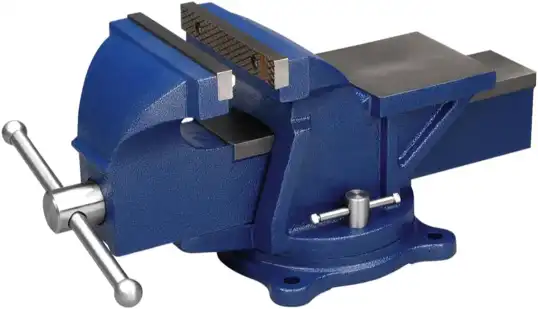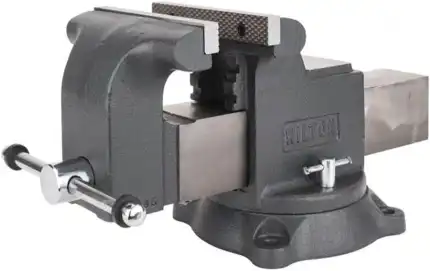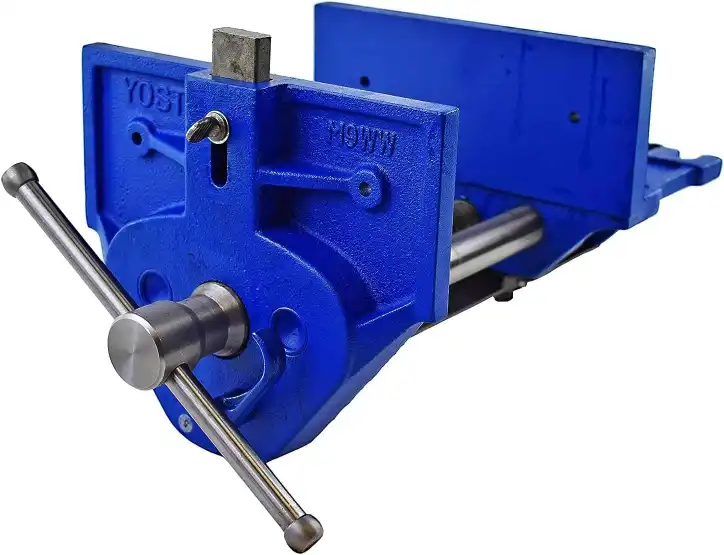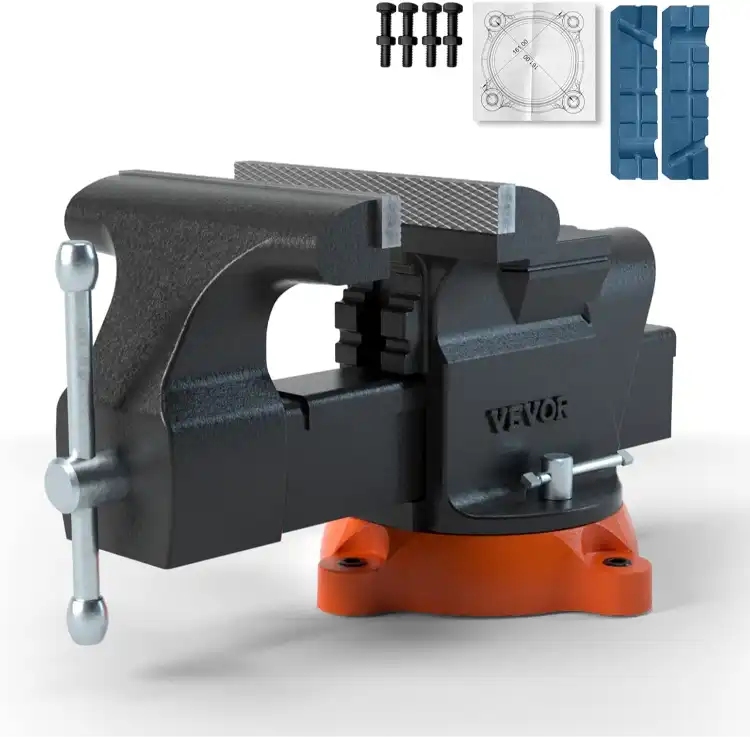A workbench vise is an indispensable tool in any workshop, whether it’s a professional setting or a home garage. This tool, often overlooked, plays a crucial role in various tasks, providing the necessary stability and security for workpieces. Its importance cannot be overstated, as it allows for precision, safety, and efficiency in a wide range of tasks.
The purpose of this article is to delve into the world of workbench vises, exploring their functionality, types, key features, and how to choose the right one for your needs. We will also look at some top brands to consider and offer practical tips for using a workbench vise. By the end of this article, you will have a comprehensive understanding of workbench vises and their significance in your workshop.
Our Top Workbench Vise Picks

Wilton General Purpose Bench Vise
Check on AmazonKey Specs
- Material: 30,000 PSI gray cast iron
- Jaw Inserts: Hardened steel, machine serrated for secure grip
- Swivel Base: 120° rotation with double lock downs
- Anvil Surface: Large, for a wide range of striking needs
- Warranty: Lifetime warranty against manufacturing defects
The Wilton General Purpose Bench Vise is a versatile, heavy-duty tool designed for both professional and home workshop use. Constructed from durable 30,000 PSI gray cast iron, it offers exceptional strength and longevity. The swivel base rotates 120° and locks in place with double lock downs for stable, precise positioning. The hardened steel replaceable jaw inserts provide a secure grip under maximum torque, making it perfect for general-purpose tasks, light-duty work, and weekend projects. Backed by a lifetime warranty, it ensures lasting reliability.

Wilton Shop Bench Vise
Check on AmazonKey Specs:
- Material: 60,000 PSI ductile iron
- Swivel Base: 360° rotation with double lockdowns
- Pipe Jaws: Built-in for various pipe sizes
- Safety Features: Rubber pinch point guards
- Warranty: Backed by Wilton’s trusted quality and reliability
The Wilton Shop Bench Vise is a robust and reliable tool built for industrial and general duty applications. Crafted from heavy-duty 60,000 PSI ductile iron, it offers unparalleled strength and longevity. The 360-degree swivel base with double lockdowns ensures easy and secure positioning. With built-in pipe jaws for handling various pipe sizes, rubber pinch point safety guards, and a large anvil work surface, this vise is ideal for a wide range of projects. The replaceable serrated top jaws provide a firm grip for heavy-duty tasks.

Yost Vises M9WW Rapid Action Woodworking Vise
Check on AmazonKey Specs:
- Jaw Width: 9 inches (22.86 cm)
- Jaw Opening: 10.25 inches (26.035 cm)
- Throat Depth: 4 inches (10.16 cm)
- Material: 30,000 PSI cast iron with chrome-plated steel
- Warranty: 1-year limited warranty, 90-day return policy
The Yost Vises M9WW Rapid Action Woodworking Vise is a top-tier tool designed for woodworkers who need fast and reliable clamping. Made from durable 30,000 PSI cast iron, it features a chrome-plated steel sliding T-bar handle and steel guide rails for smooth operation. The rapid action lever allows for quick adjustments, enhancing productivity. With a 9-inch jaw width, 10.25-inch jaw opening, and a 4-inch throat depth, it offers excellent clamping capacity. Ideal for various woodworking tasks, this vise ensures precision and stability during use.

WEN Bench Vise
Check on AmazonKey Specs:
- Jaw Size: 6 inches by 3/4 inches
- Jaw Opening: 6-3/8 inches
- Clamping Force: 3,700+ pounds
- Material: 36,000 PSI cast iron
- Swiveling Base: 125-degree rotation
The WEN 6-Inch Bench Vise is built for durability and strength, making it an excellent choice for workshop tasks. Constructed from heavy-duty 36,000 PSI cast iron, it can withstand tough use while providing over 3,700 pounds of clamping force to secure workpieces firmly. The 6-inch by 3/4-inch grated jaws can open up to 6-3/8 inches, offering versatile clamping options. Its swiveling base pivots over 125 degrees, allowing easy positioning, while the built-in anvil (4.3 by 3.6 inches) adds further functionality for striking tasks.

VEVOR Bench Vise
Check on AmazonKey Specs:
- Jaw Width: 6 inches (15.2 cm)
- Jaw Opening: 5.9 inches (15 cm)
- Clamping Force: 4,496 lbs (20 kN)
- Anvil Size: 2.9″ x 3″
- Pipe Clamping Diameter: 0.6″-2.9″ (1.5-7.4 cm)
The VEVOR Bench Vise offers unmatched strength and versatility, making it ideal for various workshop tasks. Crafted from durable 60,000 PSI ductile iron with a powder-coated finish, this vise ensures longevity and rust resistance. The replaceable serrated jaw plates, made from premium carbon steel, deliver a strong grip for all types of projects. With a 360-degree rotating base, you can position your workpiece for optimal accuracy. Additionally, the 2.9″ x 3″ anvil area and up to 4,496 lbs of clamping force make it suitable for both small and large tasks, including pipe clamping.
Understanding a Workbench Vise
A workbench vise, also known as a bench vise, is a mechanical apparatus used to secure an object to allow work to be performed on it. It consists of two jaws—one fixed and one movable—that when tightened, hold a workpiece in place. The vise is typically attached to a workbench to provide stability.
The importance of a workbench vise in various tasks cannot be overstated. It is used in woodworking, metalworking, and other similar tasks. By holding the workpiece securely, the vise allows for precise work, whether it’s cutting, shaping, or drilling. It also enhances safety by preventing the workpiece from moving or slipping during work.
Moreover, a workbench vise can also increase efficiency in your tasks. By holding the workpiece securely, it allows you to use both hands to operate your tools, leading to faster and more efficient work. It also reduces the risk of errors that could result from a moving or unstable workpiece.
Types of Workbench Vises
There are various types of workbench vises, each designed for specific tasks and applications. The most common types include engineer’s vises, woodworking vises, and mechanic’s vises. Engineer’s vises, also known as metalworking vises, are typically made of cast iron or steel and are used for holding metal workpieces. Woodworking vises, as the name suggests, are used for woodworking tasks. They often have wooden jaws to prevent damaging the workpiece. Mechanic’s vises are versatile tools used in general-purpose tasks.
Each type of vise has its unique benefits. Engineer’s vises, for example, are known for their strength and durability, making them ideal for heavy-duty metalworking tasks. Woodworking vises, on the other hand, are designed for precision, with features like quick-release mechanisms for easy adjustment. Mechanic’s vises offer versatility, making them suitable for a wide range of tasks.
When choosing a workbench vise, it’s important to consider the type that best suits your tasks. For heavy-duty metalworking, an engineer’s vise would be the best choice. For woodworking, a woodworking vise would be ideal. And for general tasks, a mechanic’s vise would be suitable.
Key Features to Consider When Buying a Workbench Vise
When buying a workbench vise, there are several key features to consider. These include size and weight, material and construction, clamping force and capacity, and mounting options. The size and weight of the vise should match your workbench and the tasks you plan to perform. A heavy-duty vise would be ideal for heavy tasks, while a lighter one would be suitable for lighter tasks.
The material and construction of the vise determine its durability and performance. Cast iron and steel vises are known for their strength and durability, making them ideal for heavy-duty tasks. The clamping force and capacity of the vise determine how securely it can hold a workpiece. A vise with a high clamping force and large capacity can hold larger and heavier workpieces.
Mounting options are also important to consider. Some vises are designed to be permanently mounted on a workbench, while others are portable and can be clamped onto a workbench when needed. The right mounting option depends on your needs and the flexibility you require in your tasks.
Detailed Analysis of Workbench Vise Features
The size and weight of a workbench vise play a crucial role in its functionality. A larger and heavier vise can provide more stability and can handle heavier workpieces. However, it may also take up more space on your workbench and may be more difficult to move or adjust. Therefore, it’s important to choose a vise that is the right size and weight for your needs and workspace.
The material and construction of a workbench vise also play a significant role in its durability and performance. Vises made of cast iron or steel are typically more durable and can withstand heavy-duty tasks. They are also more resistant to wear and tear, ensuring that they last longer. The construction of the vise, including the design of the jaws and the mechanism for opening and closing them, also affects its performance. A well-constructed vise can provide a secure grip on the workpiece and can be easily adjusted to fit different sizes of workpieces.
Understanding the clamping force and capacity of a workbench vise is also crucial. The clamping force refers to the amount of pressure that the vise can apply to the workpiece, while the capacity refers to the maximum size of the workpiece that the vise can hold. A vise with a high clamping force and large capacity can hold larger and heavier workpieces securely, allowing for more precise and efficient work.
Finally, the mounting options for a workbench vise are also important to consider. Some vises are designed to be permanently mounted on a workbench, providing maximum stability. Others are portable and can be clamped onto a workbench when needed, offering more flexibility. The right mounting option depends on your needs and the nature of your tasks.
Secure and Stable Clamping: Why it Matters
Secure and stable clamping is a critical aspect of using a workbench vise. It refers to the ability of the vise to hold the workpiece securely and stably, preventing it from moving or slipping during work. This is achieved through the design of the vise, including the jaws and the clamping mechanism, as well as the clamping force and capacity of the vise.
The benefits of secure and stable clamping in various tasks are numerous. First, it allows for precise work. By holding the workpiece securely, the vise allows you to make accurate cuts, drills, or other operations. Second, it enhances safety. A securely clamped workpiece is less likely to move or slip during work, reducing the risk of accidents. Third, it increases efficiency. With the workpiece securely clamped, you can use both hands to operate your tools, leading to faster and more efficient work.
Therefore, when choosing a workbench vise, it’s important to consider its ability to provide secure and stable clamping. This can be determined by the design of the vise, the clamping force and capacity, and the quality of the materials and construction.
How to Choose the Right Workbench Vise for Your Needs
Choosing the right workbench vise for your needs involves several steps. First, you need to assess your needs and requirements. This includes the types of tasks you plan to perform, the size and weight of the workpieces you will be working with, and the space available on your workbench. You also need to consider your budget and the value for money that different vises offer.
Once you have a clear understanding of your needs, you can start matching features to your needs. For example, if you plan to perform heavy-duty tasks, you may need a vise with a high clamping force and large capacity. If you have limited space on your workbench, you may need a smaller vise or one with a portable mounting option.
Finally, you need to consider your budget and the value for money that different vises offer. While it’s important to choose a vise that meets your needs, it’s also important to ensure that it offers good value for money. This means considering the quality of the vise, its features, and its price.
Top Workbench Vise Brands to Consider
There are several top brands of workbench vises to consider. These include Irwin, Wilton, and Yost. Irwin is known for its high-quality vises that offer excellent performance and durability. Wilton offers a wide range of vises, including heavy-duty models for professional use and lighter models for home use. Yost is another reputable brand, known for its durable and versatile vises.
Each of these brands offers a range of vises with different features and benefits. For example, Irwin vises are known for their robust construction and high clamping force, making them ideal for heavy-duty tasks. Wilton vises offer a wide range of sizes and capacities, making them suitable for a variety of tasks. Yost vises are known for their versatility, with models suitable for both woodworking and metalworking tasks.
When choosing a workbench vise, it’s important to consider the reputation of the brand, the quality of their products, and the features and benefits of their vises. By doing so, you can ensure that you choose a vise that is reliable, durable, and suitable for your needs.
Practical Tips for Using a Workbench Vise
Proper installation and maintenance of a workbench vise are crucial for its performance and longevity. The vise should be securely mounted on the workbench, with the jaws aligned with the edge of the bench for easy access. The vise should be regularly cleaned and lubricated to ensure smooth operation. Any loose parts should be tightened, and any worn or damaged parts should be replaced.
There are also several safety precautions to take when using a workbench vise. Always ensure that the workpiece is securely clamped before starting work. Avoid applying excessive force to the vise, as this can damage the vise or the workpiece. Always wear safety glasses to protect your eyes from flying debris. And keep your fingers away from the jaws of the vise when it is in use.
By following these practical tips, you can ensure that your workbench vise performs optimally and lasts for a long time. You can also ensure your safety and the safety of others in your workshop.
Conclusion
Understanding the features of a workbench vise is crucial for choosing the right one for your needs. The size and weight, material and construction, clamping force and capacity, and mounting options all play a significant role in the performance and functionality of the vise. By considering these features, you can ensure that you choose a vise that provides secure and stable clamping for your tasks.
Choosing the right workbench vise can enhance your efficiency, precision, and safety in various tasks. Whether you’re a professional craftsman or a DIY enthusiast, a good workbench vise is an indispensable tool in your workshop. By understanding the features of a workbench vise and how to choose the right one, you can make an informed decision and get the most out of your vise.
Remember, a workbench vise is more than just a tool—it’s a partner in your craft. Choose wisely, use it properly, and it will serve you well for many years to come.
FAQ
What is a workbench vise?
A workbench vise is a mechanical apparatus used to secure an object to allow work to be performed on it. It consists of two jaws—one fixed and one movable—that when tightened, hold a workpiece in place.
What are the different types of workbench vises?
The most common types of workbench vises include engineer’s vises, woodworking vises, and mechanic’s vises. Each type is designed for specific tasks and applications.
What are the key features to consider when buying a workbench vise?
Key features to consider include size and weight, material and construction, clamping force and capacity, and mounting options.
Why is secure and stable clamping important?
Secure and stable clamping allows for precise work, enhances safety by preventing the workpiece from moving or slipping during work, and increases efficiency by allowing you to use both hands to operate your tools.
How do I choose the right workbench vise for my needs?
First, assess your needs and requirements. Then, match the features of different vises to your needs. Finally, consider your budget and the value for money that different vises offer.
